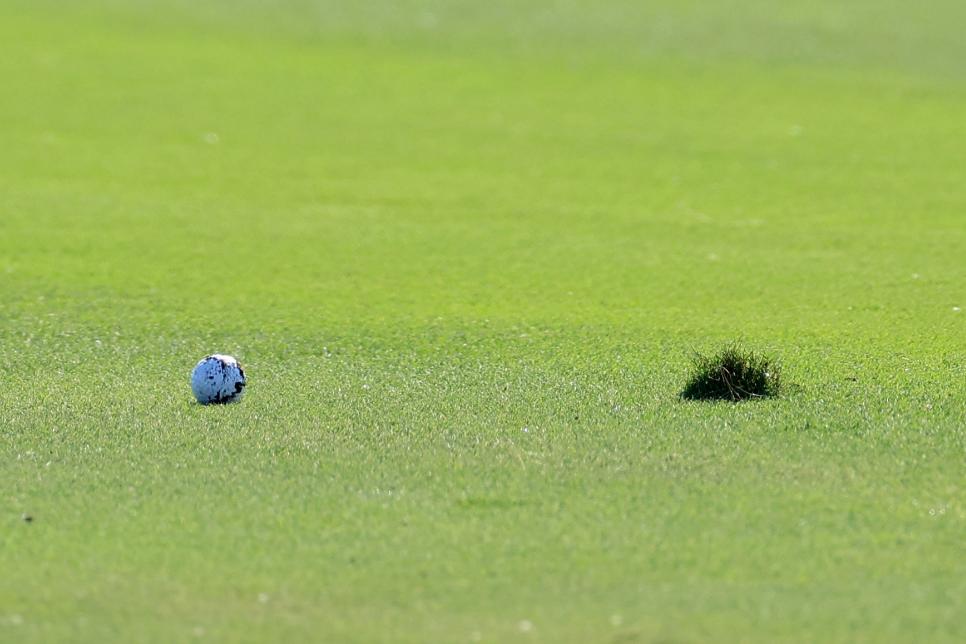[PHOTO: Fred Vuich]
At this time of year in tropical and high-rainfall areas, mud on a golf ball is an issue golfers have to deal with. Well, maybe not the pros so much. Competitive tours often enact a Model Local Rule that enables players to lift their ball, clean it and replace it on soft-and-soggy days. Everyday golfers have the right to a little help, too, so check with your course or tournament committee on whether Model Local Rules E-2 (cleaning a ball) or E-3 (preferred lies) are being used. We’ll explain more about both in a bit. We’ll also cover how to play when you’re out there to battle the elements without any preferred lies – like Bishop Pickering in “Caddyshack”.
To be clear, we’re only going to discuss here what the Rules of Golf permit or prohibit when you find mud on your ball.
Let’s start with this: if no Local Rules are in effect, you have to play a ball with mud on it (Rule 8 and 9 address this concept generally). Of course, on a putting green, you can mark your ball, lift it and clean it (Rule 13). You also can lift and clean your ball when it’s embedded in the general area of a course (Rule 16.3). The general area is most of the golf course including the rough, but does not include the teeing area you’re starting from and the green of the hole you’re on, any penalty areas and all bunkers.

To be clear, the general principal of Rule 8 is to “play the course as you find it”. But there are times when you’re allowed to lift your ball and clean it beyond the putting green. Two examples would be when you’re taking free or penalty relief. Say your ball is up against one of those irrigation-control boxes covered in mud. You’re entitled to relief from the box, and when you take that relief you’re also allowed to lift your ball and clean it before dropping it back into play. Same thing goes if you’re taking an unplayable lie – go ahead and spiff up your ball (while adding the penalty stroke) – or taking relief for a ball in a penalty area.
But here are some examples under Rule 14 when you CAN’T clean your ball:
• To see if it is cut or cracked – cleaning is not allowed.
• To identify it – cleaning is allowed only as needed to identify it.
• Because the mud interferes with play – cleaning is not allowed.
• To see if the ball lies in a condition where relief is allowed – cleaning is not allowed, unless you then take relief.
Rules Review: Are you smart enough to ace this basic rules quiz?
Another thing to remember is that you have to mark the position of your ball before lifting when a rule requires you to replace it on its original spot. You can mark your ball with things such as a tee, a coin and most artificial objects, but don’t mark your ball with a pine cone, leaf, twig (natural stuff), or it’s a one-stroke penalty.
OK, so now on to the Model Local Rules. E-2, if in place, says you can enact lift, clean and place procedures for any ball in the general area of the course. E-3 is similar, but restricts lift, clean and place procedures to parts of the course in the general area that are cut to fairway height or lower. This is what the PGA Tour does on soggy days.

MORE GOLF DIGEST RULES REVIEWS
My ball’s in the water, and it’s on the move! What are my options?
My ball is in bounds but an OB stake is interfering with my shot. Can I move the stake?
Can I be penalised for delaying play if I stop to get a hotdog or a drink?
When am I allowed to substitute a golf ball on the course?
I stopped my swing before hitting the ball. Does that count as a stroke?
I hit myself with my own ball. Embarrassment aside, is that a penalty?
What happens in a match when no one knows how to apply a rule?
My opponent stopped my ball from rolling on purpose. Is that a penalty?
While waiting to play a shot, my opponent is killing time by chipping a ball. Is this allowed?
My ball is in a penalty area, so what are my options for taking a drop?
Can I be penalised if someone else improves my lie?
Can you repair divot holes or pitch marks in your line before hitting a shot?
I just played the wrong ball. What do I do now?
What do I do if my ball just hit another ball on the green?
What do you do when the tee markers aren’t lined up or are missing?
Somebody just picked up my golf ball! Now what?
Crazy things that only happen in matchplay
Can you hit a provisional ball after hitting a shot into a penalty area?
Your club breaks, what are your options?
My opponent took a generous drop after hitting into a penalty area. Can he be DQ’d for that?
Can I use a long putter when measuring my relief area?
Our practice putting green sucks. Can I hit a few putts on the course before my round?
I had an extra club in my bag and I just teed off. Now what?
Can I move a stone if it improves my lie?
Are you smart enough to ace this basic rules quiz?
Do I get relief from aeration holes?
What does ‘known or virtually certain’ really mean?
Do you have to use a putter on the green?
You’re playing a Srixon. Two holes later it’s a Callaway. Is switching golf balls mid-round allowed?
I hit a horrible shot. I’m waaaaaay better off if I don’t find the ball. Can I just declare it lost?
I’m on the green, my opponent is not. Who’s away?
Is sneaking a peek in another player’s bag considered getting advice?
What do I do if my golf ball is stuck in a tree?
I conceded a putt. My opponent putted anyway and missed. Is that a penalty?
What is casual water and how do I play around it?
I thought my ball was lost and put another in play then found my first ball… which ball counts?
What happens if I can’t tell my provisional ball from my original?
What exactly is an embedded ball?
How do I find my ‘nearest point of relief’?
How long can I take to hit a shot?
Does a ball have to be unplayable to declare it unplayable?




